| Report Type | Full |
| Peak(s) |
Longs Peak - 14,259 feet |
| Date Posted | 07/13/2023 |
| Modified | 07/14/2023 |
| Date Climbed | 06/10/2023 |
| Author | JacobW |
| Kieners, a First Descent |
|---|
Kieners, a First DescentWhile I stood above, filming from my phone, Sam set off. One jump turn, followed by a second and a third in quick succession. I thought it looked remarkably agile and confident given that Sam pivoted around a single pole as his other hand was occupied with an ice tool. While he hopped down the snowy chute, chunks of saturated, weak snow broke away sliding down the slope before disappearing off the end. I could only imagine how dramatic it looked for people at Chasm Lake to see these sloughs careen 1,000 feet down the east facing diamond after they went out of my sight. Or, maybe they were distracted, trying to figure out why someone was skiing down the most exposed little patch of snow imaginable. In early June, Sam and I completed a several year dream of putting ski tracks on the most impressive alpine face in Colorado; Longs Peak's East Face. Onlookers would question the risk vs. reward for such a ski line, but below I tell the story of how we approached such an objective and why the turns (or lack of) were hardly the reward we were in it for. The Idea: What can be skied?Sam and I have been interested in finding challenging, aesthetic, or creative ski descents for a number of years now. As two Colorado natives who grew up skiing, we each spent our college years getting comfortable in the backcountry and testing the waters in ski-alpinism. It's quickly apparent that this is where type 2 (maybe 2.5) fun thrives. Adding skis to mountaineering days means that you work considerably harder and usually enjoy worse snow than a typical mid-winter backcountry day, but the reward is unforgettable days in cathedrals of rock and ice. Since college, Sam and I have ticked off a long list of classic ski descents and built confidence in the alpine and trust in each other. We also share the affliction of being weekend warriors, so most of our missions are confined to objectives in striking distance of Denver with the exception of one or two longer trips each year. So, after skiing Dragon Tail 5 times, James Peak 6 times, and Torreys 15 times (including many times in a day) we naturally started wondering about what's adjacent to the lines that people usually ski. Of course, being the front range of Colorado, the answer is typically: chossy rock. RMNP in particular is an alpine haven of rock routes, more than a person could dream of climbing in a single lifetime. This rock seems to persist through the winter months, even though it does snow in the park, it appears to get more wind than snow. I like to remind people that it's called rocky mountain national park, not snowy mountain national park. So, instead of looking for recorded ski lines that are particularly difficult to achieve, we took the approach of looking at climbing routes which, under the right conditions, could be skied. Our first test at this was back in April 2018, when we dropped into a cute between Dragon Tail and Dead Elk which Sam had spotted a year earlier while skiing Hallett's north couloir. Despite the relatively high snow, it was still barely enough to justify bringing skis down. The descent involved 3 rappels, but still ended up being a fantastic day. After doing more research on the line, we found that it likely had been climbed before but never skied, and never named. So, we coined it Smoke and Dragons. 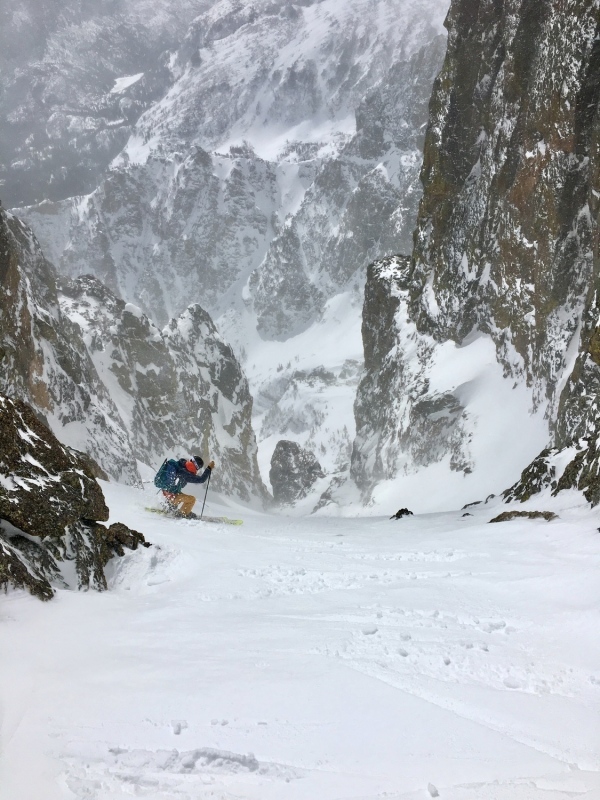
After that experience, we filled a drive to the tetons along with a few more backcountry days discussing classic climbs that we were familiar with and which ones might be skiable, in the right conditions. Some of the others we were interested in included; north face of Toll (likely more rappelling than skiing), Liberty Ridge on Rainier (dramatic and huge, but gets skied semi-regularly), and the north face of Assiniboine (too far for us to effectively hit a conditions window). A common trend for these was that they're nearly all climbing routes which could be skiable with extraordinary snow coverage. Kieners was a bit of an outlier here, since we knew from climbing experience that it melts out very late in the spring, meaning it must hold a lot of snow, most years. So we proceeded to work on trying to make a few of these work. We worked with a heli-ski operation in Canmore to collect beta on Assiniboine and I worked with some local pilots to collect images of Toll after storms. None of the information we collected from these was encouraging and the two of us have all but abandoned both of those dreams. March 2021 produced one of these extraordinary storms right in our backyard. With roughly 3 feet of snow in Boulder, Sam and I scrambled to tag a ski descent of a classic climbing objective that nearly everyone should recognize, the third flatiron. We made our way to the base of the flatiron with gear to climb and ski it. However, we found that the upper parts of the face had seen some wind, so there didn't appear to be enough snow to ski much above the midway point of the rock. So, we clipped into our skis and made the most of the bottom half of the face, skiing from the east bench. This was still steep and tricky, since some turns were good and snow-filled, while others went right to rock and resulted in sliding until deeper snow was found. It is very important to note that the third flatiron is closed for raptor nesting in March. Sam and I were both ticketed for this. That same year was, kind of, our first year of seriously looking into skiing Kieners too. We had some beta from my previous climbs, a remarkable spring snowpack which didn't seem to want to let winter go, and I was in, most likely, the best shape of my life. However, by the time things were settling enough to contemplate taking it on, Sam and I were in the midst of preparing for a trip to climb and ski Denali. In fact, the first window to go after Kieners came up the weekend before we were supposed to depart for Alaska, so we decided it would be pushing our luck to take on that risk right before going on a trip where our whole team depended on each and every member. So, we let it rest until the next year. Spring 2022 came around, and it turned out to be one of the years where Kieners might not have been skiable. Or if it was, there was likely only one window, which we missed due to trips, obligations, or just because everything melted really fast last year. So, still motivated, we came into this spring with the same attitude, "if a window hits, we'll take it." The Lead Up: Spring is the best season in ColoradoApril came around this year and we both started making it a daily habit of checking the Longs Peak webcam and the weather forecast. In the beginning of spring, it wasn't looking promising. Although it had been a fairly snowy winter for the front range, it had also been a very windy winter. This didn't make us too concerned since we knew to wait for wetter, spring snow to start blanketing the higher elevations. I enjoyed a spring full of skiing adventures, including a weekend at Opus Hut, a few great days on Torreys, and trip out to California to ski Shasta with a group of friends. The whole time, Kieners was at the back of my mind. While I was descending the East Face of Torreys, I was wondering how similar the exposure on that would feel compared to Kieners. It turns out that the East Face is far less scary, however it still required careful attention to make sure you hit the right exit, a little chute in the middle of the face. Through all of this, Sam and I often discussed plans for Kieners, either to remind ourselves of the plan, confirm that each of us were on the same page, or just to confirm that the other is still thinking about it. We knew the plan was to climb the north face, since this would be faster than going up Kieners. And we expected to rappel from the end of the ramp into Notch Couloir, which I was fairly certain it would be ~50'. Lastly, we both agreed that the scariest part of the day would likely be exiting across Broadway, which the decision whether or not to rope up would depend on the conditions of the day. The first weekend that looked very promising for Kieners was the weekend of May 20th. However, I had commitments to run fast for my work's Colfax Marathon team. So, I chose to lay low that weekend and not commit to any alpine starts. After that, I was off to Shasta, and the weekend after that was just too stormy to get up high. We continued to be patient, even when the weather wouldn't accommodate alpine objectives, it was still dropping 3-5 feet of sturdy, spring snow, filling things in. Finally, everything seemed to line up. Even though we were approaching mid-June, the coverage on Longs, the weather, and our schedules were all promising enough that we really didn't have any excuse not to give it a shot. The Climb: Go TimeWe met at my house, in Boulder, at 2 AM (Sam actually showed up about 15 minutes early which I believe was a fluke, not related to excitement for the day) and headed off to the Longs Peak trailhead. We got there a little later than expected since I accidentally took Hwy 36 all the way to Estes, but we got there early enough to park in a prime spot and start setting up gear. I carried a 60m half rope, ski gear, harness, ATC, bail gear, one lightweight axe, and a whippet. Sam carried a small rock rack, two ice tools, ski gear, etc. We started up the trail, at a good pace, in trail runners. Even though we were passing other groups and moving well, we still moved a little slower than I had anticipated. We were just crossing Storm Pass at sunrise. 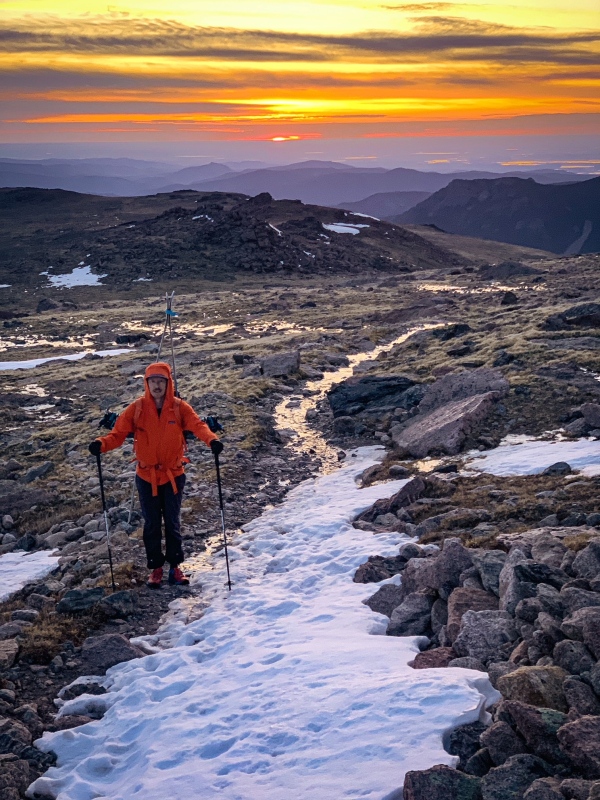
We continued along, taking a break at the Boulderfield campsite and pushed up towards Chasm View, aware that the schedule was slipping but enjoying the amazing morning that was just getting started. 
A couple hundred feet below Chasm View, we stopped again, to switch from trail runners to ski boots and crampons. Putting crampons on always gets me excited for what's next. It feels pretty involuntary, like my body knows that these are tools that will propel me to somewhere special. We continue up to Chasm View and then follow a single set of tracks up the North Face. 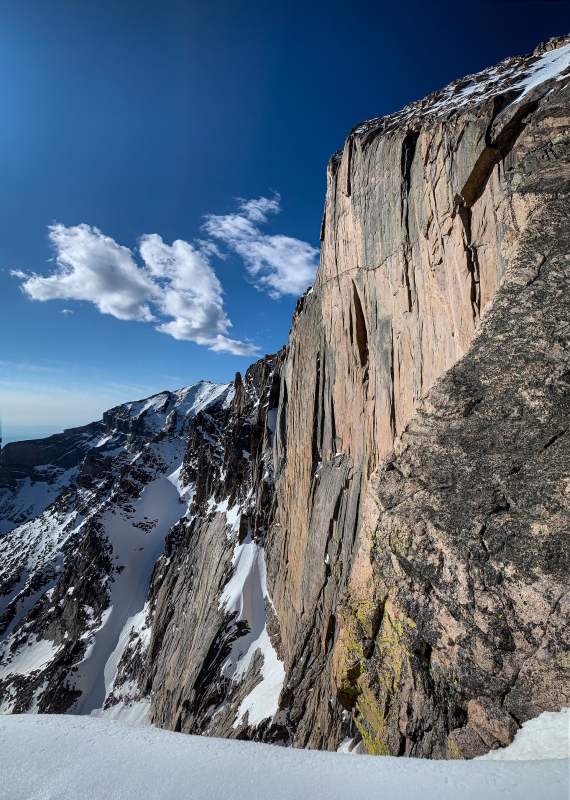
Climbing the North Face was delightful. Just the right amount of snow and ice to make it quick and secure. The little bit of ice, smearing the typical crux, was slightly exciting with my dinky, lightweight axe in one hand and a whippet in the other, but it worked out with some careful feet. As we neared the summit we saw the solo climber who's tracks we had been following. He was now on his way down, spirited by getting the summit all to himself on a clear day. 
We made it to the summit just before 9 AM. We discussed that this was later than we had hoped, and I was content with the idea that we gave it a shot, but we will need to come back and try to get to the summit earlier. Our main concern with timing wasn't entirely about the ski line getting out of condition, it was mostly a concern for crossing Broadway too late in the day to do it safely. As we recouped on the very familiar summit plateau (this was my 35th time summiting Longs), another climber seemed to appear out of nowhere. Whoever this person was, he managed to exude a level of stoke which, to be honest, rubbed me the wrong way at first. However, after we explained our objective and our concerns about timing, he brought up a comment that simplified our conundrum, "you're here, you might as well go look". Sam and I looked at each other, we confirmed that both of us still felt good (energy-wise), and we talked about the gear a bit. We have everything we need to deal with some unsafe snow conditions on Broadway, we're probably just committed to pitching it out at this point... which we were prepared for. Also, if we get to the snow and it's bad, we can come back and give the north face a shot. So, yeah, thank you stoked stranger, we will go take a look! This decision seemed to further elevate our new friend's excitement, making both Sam and I more eager to get the job done. The Descent: It's all down from here (or sideways)We headed back to the north face, with a more eastern track this time to find the start of Kieners. This was a little tricky, since I had climbed Kieners many times before, I had never descended it, so I knew that the entrance wouldn't be very obvious. Several people have asked me if we tried to descend the fingers of snow that track up from Kieners to the summit. Since it was June now, those were very narrow, very rocky, and extremely steep. So no, we didn't consider them for more than a moment and chose to hike down, reversing the usual climbing route. We started running out of slope, but gained a view of the Kieners snowfield below and I began down-climbing the rock to get to it. This still felt off-route, but I knew I was close. With one awkward motion (spurred by down-climbing in ski boots, with crampons, and a ski pole in my hand), I managed to unclip the flick-lock on my whippet and wave the pole in a way that the lower half flew out and started bouncing down the ledges below me. I froze and watched it, dreading the moment that it goes out of sight. By a miracle, it stopped on the last visible ledge. "Oh my god, the last thing we need right now is stupid errors" I lectured to myself as I looked for a way down to the ledge. Then, while observing the area where it landed, I realized that was exactly the spot where the regular Kieners route passed over the tip of the diamond and onto the North Face. Eureka, we've found the spot we were looking for. Now, Sam and I were even more sure of our decision to continue, not from solid evidence but instead from something more supernatural. It seemed almost like the stranger appearing at the summit and the pole freeing itself to show us the way were omens, encouraging us to continue. This, of course, is ridiculous, but we'll take whatever good news presents itself at this point. We negotiated the fifth class downclimb to the shelf carefully, with skis on our backs and boots on our feet every move had to be pretty certain. 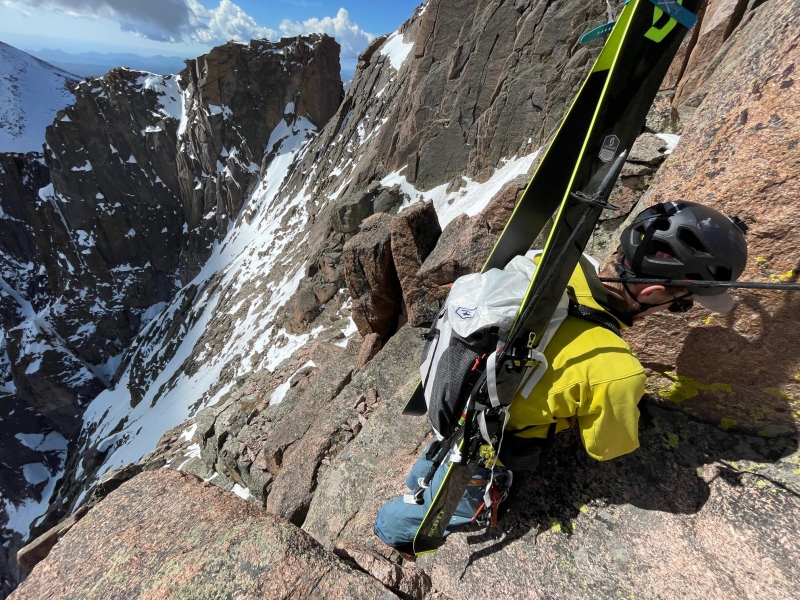
This little bit of descending took us longer than expected, again. So, by the time we were on the Kieners bench, with skis on, it was just after 10 AM. 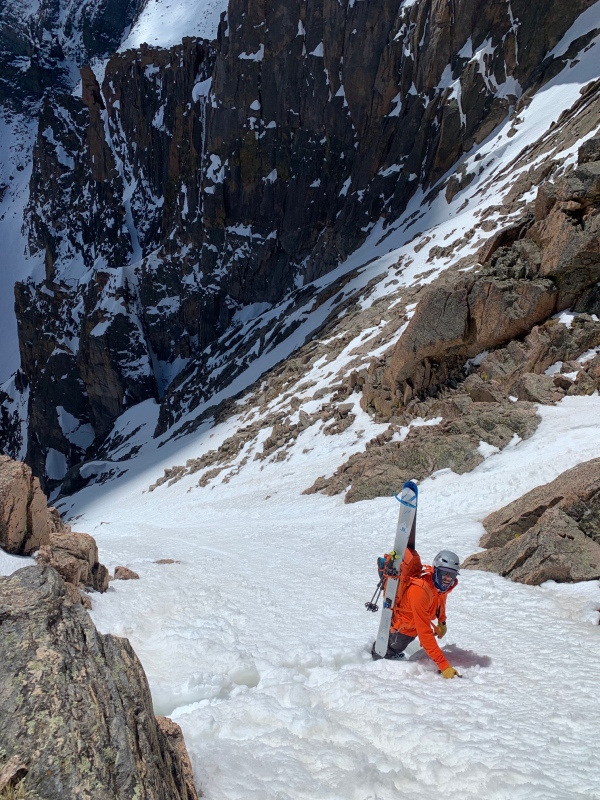
We began skiing, with Sam going first. He exclaimed, "it's not that bad" and he put down some committing jump turns. Every other turn would release a small amount of snow which would cascade down the face and disappear over the edge below. As he got further though, each turn released more wet snow. I immediately thought, "it's getting worse". After he got to a good place to stop, I started down, opting to just stick to my right side edges and not go for jump turns since we didn't appear to have any margin for error. After all, there's nothing heroic about pushing it at this point, just getting down on skis and making it back to the car alive were really the requirements for completing this. So, I scraped my way down, keeping the downhill ski light so I could pick it up occasionally to release the loose snow from the top of it. And it was actually pretty enjoyable, we were skiing, in this incredible spot. The snow wasn't ideal, but in patches where it had some consistency, I could pick up a little speed and feel some fluidity. We stuck somewhat close to the rocks on the right side, since exposure to the left was imposing, and after just a couple minutes we were at the end of the Kieners shelf. Well, there you go, we skied it. From this position, there isn't a way, on snow, to get to broadway. The usual route comes directly up some slabs with sustained sections of low-fifth class, however our plan was to skip this by rappelling into Notch Couloir. I've scouted this in the summer (twice) and it looked like there should be several options for sturdy anchors by slinging large blocks. However, I underestimated the depth of the snow in the winter. Only one, crumbly tower of rock was protruding from the snow. So, Sam and I worked together trying to find a way to make an anchor out of it that we could trust our lives to. This isn't like making a trad anchor on a classic route, it's more like trying to find a way to rappel off of a cairn. At one point I mentioned that we're late enough that my wife, Amanda, is surely going to start getting worried soon. She has had to notify authorities of me being late before, and it's not a situation I could afford to repeat. However, this wasn't the best spot to let distraction in and I promised myself I'd contact her once we were a little more secure. After a lot of prodding, prying with ice axes, and attempts to feed cord through tiny gaps, we finally put together something which utilized a couple nuts, some cord, and the rap rings I brought. Sam went first, lowering himself down the 60m twin rope I brought and he disappeared out of sight. Right after he started, he mentioned that the rope looked to be just long enough. This along with the length of time it took him to descend really surprised me, I thought it would have been shorter to get into Notch Couloir. However, after a couple minutes, I got the very welcome "off rappel!" call. I clipped in, eager to get off this ledge and move one obstacle closer to safety. 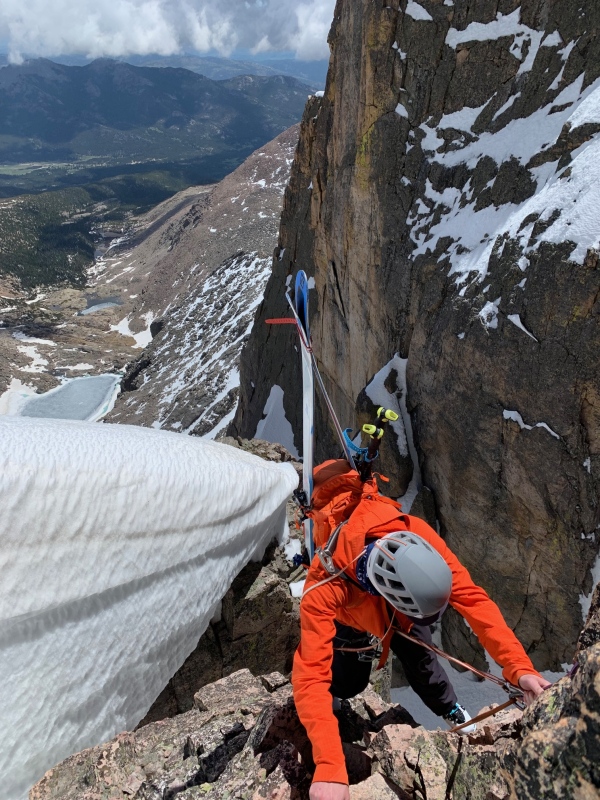
I made it down to Sam, where he was visibly relieved that the anchor held. Both of us were pleased that we had completed the main part of our objective, but felt like we had taken enough risk for one day and opted to leave the skis on our packs, rope up, and stay on-belay from here to Lambslide. Sam started, leading down the couloir until we were nearly out of rope, at which point he made his way to the skier's-right wall and made a deadman anchor with his ice tool. I led the next pitch, making it onto broadway and hastily put some rock protection in now that there was ample placements. After getting my second piece in, and out of sight of Sam, I heard the familiar rumble of an avalanche releasing from behind and above me. I knew I was in a safe spot, but Sam was still in the couloir. I sped up, trying to pull more rope through to slightly shorten any fall that Sam would have if he was caught and sent off of Broadway. But after a moment, I saw the torrent of snow wash over Broadway, further to the north. It didn't seem close enough to have come down Notch, and the rope remained still. "I guess I should try to get Sam out of there," I said to myself and began looking for places to build an anchor. I belayed Sam to my position, checking that he wasn't too spooked by that slide once he was within earshot. He said he was fine, and cracked some joke which made both of us smile. Once he caught up with me I mentioned the mounting need to contact Amanda. "I NEED to let her know that we're running behind, but are okay," I said as I looked for a position secure enough to take my pack off to get to my inReach. Sam agreed that made sense, and then check his phone and behold, he had reception. We actually got a call through to Amanda to encourage her that we were okay and would contact her again when we were at Chasm Lake. Sam then took another minute to text a similar message to a few more people before leading off the next pitch. 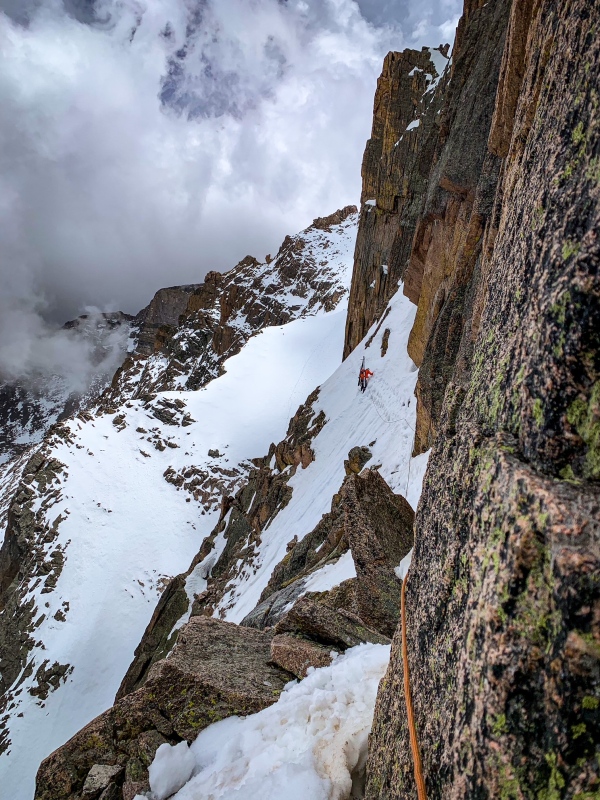
As we worked our way along, clouds started building and darkening around the peak. An ominous sign which then got even worse when thunder started shaking the mountain. We knew this wasn't good, but we had shells with us and were more inclined to sit out the rain than rush our progress along the ledge. I thought about the possibility that rain could make the snow more treacherous, but figured that, with how saturated it already was, adding more water probably wouldn't make a difference. We continued slinging leads with the encouraging thought that, with each step forward, the drop to Lambslide was getting smaller. Miraculously, the rain held off, and we were just treated to about 40 minutes of threatening thunder. I led the fourth pitch, happy to find a piton in the wall just as I was running out of rope, and then belayed Sam to me. As he got into sight, but was still maybe 80 feet from the anchor, the snow he was standing on gave out. Sam shouted, "NO!" as he slid. But, with a single ice axe swing, he arrested his fall, maybe 7 feet below the bootpack. Even if he wasn't able to self-arrest, he was luckily right below a solid #1 camalot and I certainly wasn't going to let him slip through the belay. Despite this, he was slightly shaken and I took on the next lead as well. I was happy to take this lead since it involved a section I had some beta on. There appeared to be three options; two shelves which only one appeared to have enough snow to stand on, but both offered very little gear, and a third option which was a narrow, steep chute we would have to ascend. One of my friends had climbed up here a few weeks before and showed me photos of this chute, "it's definitely the way to go" he told me. So I began up the chute, which sparked a "where the hell are you going" from Sam. I tried to encourage him, but understood that it looked ridiculous and unlikely to improve our position. I decided the best way to convince him was to lead up there and encourage him from the top. So, I got one cam in the bottom of the chute and thought, "Alex, you better not be pulling my leg" as I set off. This chute was actually really cool. Steep enough that it required some climbing technique. I would sink and ice axe and crampon into the water-ice on the right side then use my left hand to stem against the wall. I continued that to the top of the chute where I got a welcoming view of easy snow connecting my position to Lambslide, about 100 yards away. I yelled to Sam that it worked, and went off to build an anchor. Sam led the final pitch, I enthusiastically followed under the encouragement that we could ski from his position. At this point it was nearly 4 PM, and we knew that Lambslide would ski terribly. However, we welcomed it, knowing that only something catastrophic could prevent us from making it out at this point. We held off our celebration until we were at Mills Glacier, where we snacked on salami, wrung out our leather gloves, and gaped at the imposing rock face above us... which we had just skied! 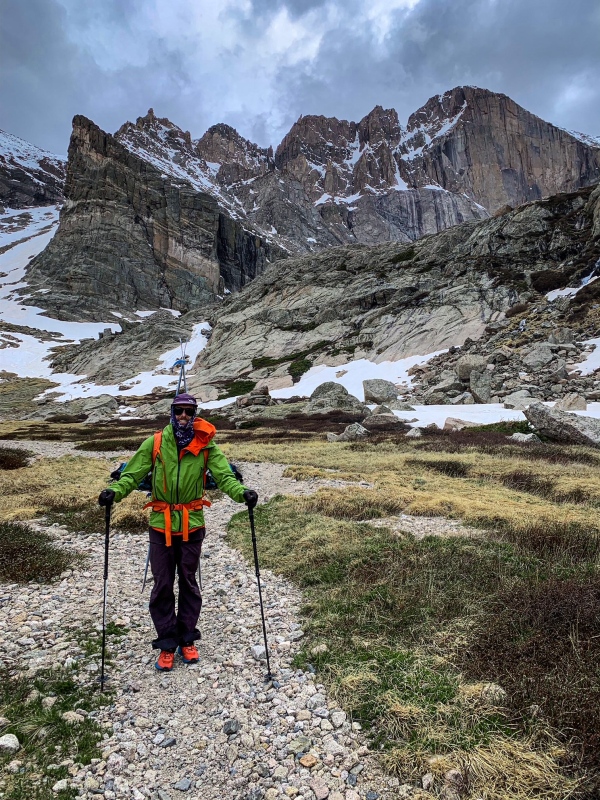
We continued down, skiing around the Chasm Lake and skirting the moraine. When the snow stopped we returned our skis to our packs and our shoes to our feet while taking another long break to let friends and family know that we were safe. We had about an hour and a half hike out to discuss the day. What went to plan, what didn't, why we decided to ski despite the timing, and how massively we lucked out on weather. In the end, most of it went as planned, the biggest diversion was the difficulty of the rap anchor. Our decision to ski, I would still consider questionable, and I don't have much evidence that it was the right decision. Sam added that it likely would have been much better two weeks earlier, which makes sense. Am I pleased with the day? Yes, how often do you get to combine that many alpine challenges into a single day? Will it get skied again? I imagine it will, and I hope people take some notes from this to get it in better condition. Will Sam or I ski it again? Absolutely not. Prologue: Is it a first Descent?After we had recovered from our day, Sam and I went about digging further into the ski community to see if anyone could confirm a previous ski descent of Kieners. Although many people told stories of local legends skiing it or vague recounts that "everything in the park got skied in the 80's and 90's", no one could come forward and say that they themselves had skied it. I put in the work of contacting everyone who people had claimed skied it and each of them confirmed my suspicion that they had not skied Kieners. That doesn't mean that I'm certain it's never been skied before, but we have some confidence that it was a first descent. Our story got written up in Powder Magazine, making us officially famous, right? I still wanted to put together a full recount of it so I can refer back to it later, and in hopes that some of you enjoy the story as well. |
| Comments or Questions | |||||||||
|---|---|---|---|---|---|---|---|---|---|
|
Caution: The information contained in this report may not be accurate and should not be the only resource used in preparation for your climb. Failure to have the necessary experience, physical conditioning, supplies or equipment can result in injury or death. 14ers.com and the author(s) of this report provide no warranties, either express or implied, that the information provided is accurate or reliable. By using the information provided, you agree to indemnify and hold harmless 14ers.com and the report author(s) with respect to any claims and demands against them, including any attorney fees and expenses. Please read the 14ers.com Safety and Disclaimer pages for more information.
Please respect private property: 14ers.com supports the rights of private landowners to determine how and by whom their land will be used. In Colorado, it is your responsibility to determine if land is private and to obtain the appropriate permission before entering the property.
